Kingdom of the Fishes
TRITON BAY, INDONESIA, was one of the last places I visited before the COVID-19 pandemic struck. Looking back, part of me wishes I would have been there instead of at home when the world turned upside down and international dive travel became almost impossible.
An extended sabbatical in the middle of bustling hordes of fish and wildly colorful coralscapes would have been therapeutic. Having the ocean to yourself — or more accurately, feeling like you are the only human for miles and the marine life infinitely outnumbers you — drove me to this outpost in the wilds of West Papua in the first place.
With Indonesia finally open for travel again, it is an excellent time to giant stride into these fishy waters flowing far outside the mainstream. How far? I flew more than 7,000 miles (11.265 kilometers) from landlocked Spokane, Washington, to submerge in these current-swept, critter-packed seas. Your mileage may vary, but unless you live in eastern Indonesia, expect a long haul to reach Kaimana, the gateway to the Triton Bay region. Once I was submerged, however, my exhaustion faded immediately.
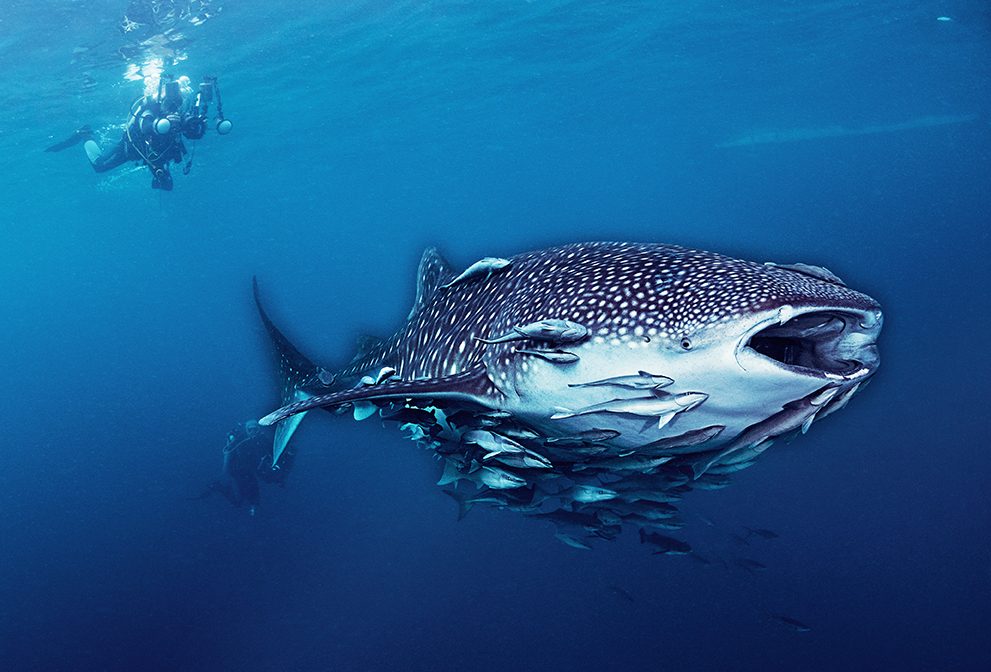
Brock’s nudibranch (below right) to huge whale sharks (above). BRANDON COLE
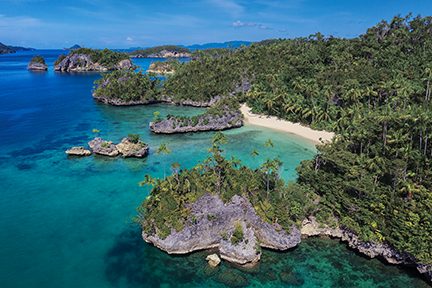
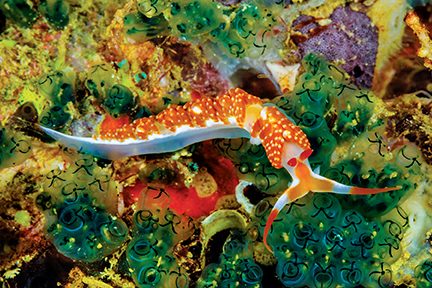
BIG FISH, LITTLE FISH
On my first day at Triton Bay, I swam with whale sharks, which proved an effective and exciting pick-me-up. The encounter was courtesy of local fishers, who have a fascinating symbiotic relationship with the enormous elasmobranchs. Targeting ikan puri — small, anchovy-like fish — fishers drop nets each night from their boats near Namatota Island. Early the next morning they haul up nets bulging with baitfish, and a hungry whale shark or two often follow the enmeshed, glittering prize. Some sharks succeed in sucking the tiny fish right out of the nets. Others are more civilized and wait with mouths agape for a tossed handful of the catch.
Our resort pays the fishers to offset the loss of fish they donate to the sharks. This stipend is also a thank-you for allowing lucky souls like us to dive around the bagans, the fishing boats with wide bamboo lattice platforms. Scientists also benefit from this unique shark drive-through, which allows them to tag and monitor the visiting whale sharks and learn more about their numbers and movement patterns. The valuable information gained through this research aids conservation efforts.
I spent the entire hourlong dive awestruck by two whale sharks about 18 to 20 feet (5,5 to 6,1 meters) long, one of which hosted a squadron of remoras. From a photographer’s perspective, it was like shooting fish in a barrel compared with the speed demons I had seen elsewhere. These whale sharks were not in a hurry to go anywhere. They just wanted to lazily snack beneath the bagan, making it surprisingly simple to get close with my fisheye lens.
Shallow coral gardens and slopes strewn with boulders are among the fishiest I have ever explored in Indonesia, the entire Coral Triangle, and, for that matter, anywhere in the world.
Photographing these behemoths was easier than the pygmy seahorses, another Triton Bay superstar, albeit at the opposite end of the size spectrum. We saw four different species at a spot called Tangga on the east side of Aiduma Island. Our keen-eyed guide did the finding and patiently pointed them out to me as I repeatedly lost them while putting my camera to my mask. So clever was their camouflage and so tiny their size — the Pontoh’s and Satomi’s species seemed microscopic — that I was completely outmatched. My self-esteem ebbed dramatically until much larger, less wily Bargibant’s seahorses graciously appeared in both yellow and pink color morphs.
With momentum building, we moved farther down the shelving reef to an obliging orange Denise’s pygmy seahorse and one of its Santa Claus variants living on a carmine-colored gorgonian at a depth of 55 feet (17 meters). Sporting whitish bumps on its red body, this thumbnail-sized seahorse cruised about its domain, jerkily jumping through the tentacle forest from one blue-and-white polyp perch to the next.
During this dive and the other pygmy seahorse photo sessions on this trip, there were only a few of us in the water instead of the dozens of sometimes-pushy divers queued up that I have experienced at other destinations. With the diminutive celebrities not completely overwhelmed by admirers, the relaxed and impressively productive pygmy-hunting opportunities in the Triton Bay area are reason enough to venture there.
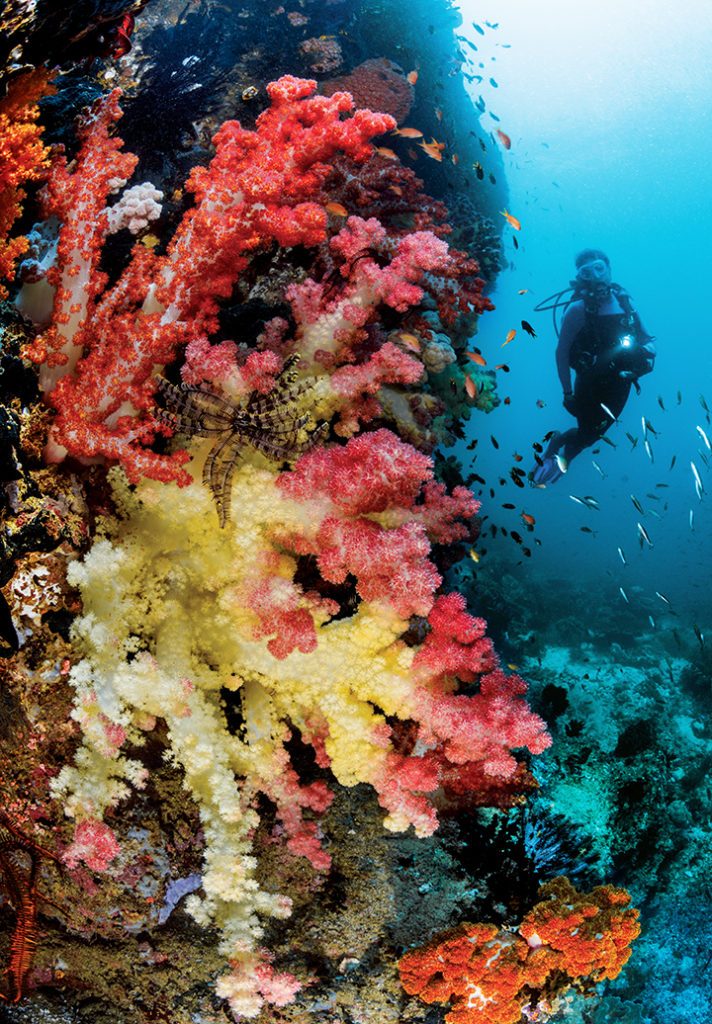
These colorful soft corals (Dendronephthya sp.) are filter feeders, ensnaring tiny bits of plankton from the passing water.
BRANDON COLE
EVERYTHING IN BETWEEN
Most of our dives for the week were in Iris Strait, which runs north to south between Triton Bay on the West Papua mainland and Aiduma Island. Strong currents move abundant phytoplankton and zooplankton up and down through the strait, fueling the food chain for all the reef residents. Shallow coral gardens and slopes strewn with boulders are among the fishiest I have ever explored in Indonesia, the entire Coral Triangle, and, for that matter, anywhere in the world. No wonder the nascent dive tourism industry there proclaims the Kaimana Regency as the “Kingdom of the Fishes.”
Batu Dramai, a 30-minute boat ride from the dive center, is a rock (batu) in the southern opening of Iris Strait. Being exposed to the weather makes it sometimes inaccessible, but if you have the chance, do not miss this site. We dived it twice, with both backrolls dropping us right into the eye of frenetic, fantastic fish action. Schools of fusiliers streamed in all directions, passing slower surgeonfish and being overtaken by faster jacks. Hundreds of silver and scarlet Pinjalo snappers threaded through the traffic and arced in tight formations over table corals, soft coral bushes, and rocky ridges on which neon yellow-green crinoids unfurled their sticky feeding arms. Muscular giant trevallies looking for lunch chased smaller fish. Cleaning stations staffed by bluestreak wrasses were doing brisk business, servicing angels, sweetlips, and groupers. From under a ledge, a tasselled wobbegong shark with a scraggly beard watched the world swim by, apparently content not to burn the energy required to join the fray.
Aquarium on Saruenus Island is another stellar site where the current pumps up the marine life, especially the stationary filter feeders waiting for delivery of their planktonic meals. Rainbowed soft corals shellack boulders as large as our bungalow. With much of the jaw-dropping scenery only 10 to 20 feet (3 to 6 meters) deep, the fiery reds, oranges, and yellows were dazzlingly bright. Purple tunicate clusters, feathery hydroids, striped feather stars, and mounds of pink cup corals share the resplendent real estate with the soft corals. Baitfish and anthias swarmed past us.
Endemism is exciting to fish geeks like me. One of my old marine biology textbooks described it as “restricted in geographical distribution to an area or region.” I usually say “found nowhere else …”
I followed bluering angelfish for 15 minutes as they plucked at algae and sponges. I desperately wanted a newer, better picture of this striking fish, so I mostly ignored other species on my wish list (including a bold barramundi cod and two obscure cardinalfish) doing their best to distract me.
Little Komodo is next door and is often combined with Aquarium when the current cooperates and dive guides give the green light. While snorkeling and offgassing, I worked on over-under photos framing the island’s rugged karst and green jungle with blooming soft corals just inches below the surface. Such an unusual and photogenic combination has been a rarity in my travels elsewhere, but dramatic vistas are commonplace in this under-the-radar corner of Indonesia.
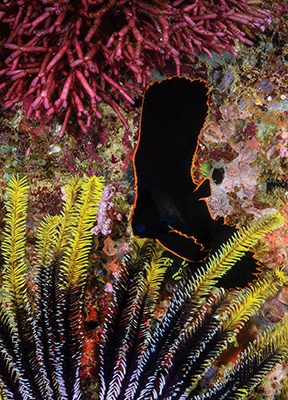
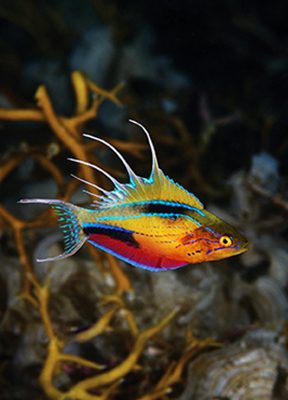
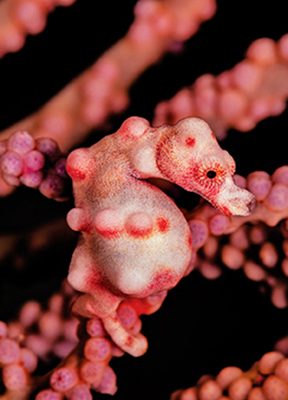
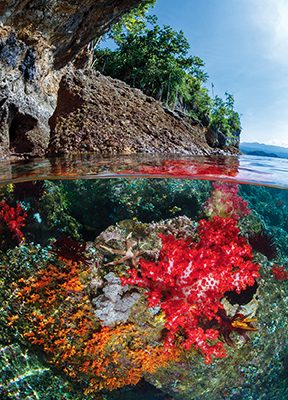
Above, clockwise from top left: A juvenile pinnate spadefish (Platax pinnatus) glides through colorful crinoids protruding from the reef. • This 3-inch-long male Nursalim flasher wrasse (Paracheilinus nursalim) is displaying for females as part of courtship behavior. • This dramatic split-level view shows the jungle-covered island above the waterline and colorful soft corals on the reef below. • Denise’s pygmy seahorse (Hippocampus denise) is less than 1 inch long and lives on gorgonian sea fans, on which it is often well camouflaged. All above photos BRANDON COLE
RARE AND REMARKABLE
Endemism is exciting to fish geeks like me. One of my old marine biology textbooks described it as “restricted in geographical distribution to an area or region.” I usually say “found nowhere else” when in mixed company at the dinner table. A scientific explanation also might not make anyone abandon their meal, run to the beach, gear up, and dive into the dark to observe an ambulating Hemiscyllium henryi elasmobranch. But mention a spotted shark walking on a coral reef, and everyone is much more likely to run from the table.
That is exactly what happened when I saw my first Triton epaulette shark — also called the Triton Bay walking shark — after sprinting to the beach. Other epaulette sharks in eastern Indonesia, Papua New Guinea, and northern Australia look similar, but this specific species is only here. This ocellated, serpentine night crawler is yet another reason to fly across the world to Triton Bay.
Dozens of endemic species lurk in the local waters, including the recently discovered Nursalim flasher wrasse, a charming creature that brought me to tears of both joy and frustration. When overcome by the desire to impress his harem, the rakishly beautiful 3-inch (8 centimeters) male displays his eye-popping iridescent coloration and spikey fin plumage while darting about in all directions at whiplash-inducing speed.
These lively courtship acrobatics happen daily at dusk, when the lighting is just romantic enough for camera autofocus to struggle. It is a fantastic yet fleeting performance. For someone not gifted with lightning-fast eye-mind-finger reflexes, it is an extraordinarily difficult behavior to capture on camera. This attempt made even my pygmy seahorse endeavors seem like a cakewalk. While other guests relaxed beachside, I tortured myself for nearly five hours over three dives on the resort’s house reef, admiring and cursing the flashers in equal measure while hammering the shutter hundreds of times. While only seven of the photos were in focus, all the pictures of the real-life drama stored in my mind were perfect.
What’s going on, biologically speaking, in these warm, blue-green seas? It is widespread knowledge that this part of the planet has incredible marine biodiversity. The Coral Triangle has more than 2,000 reef fish species, almost 600 corals, and a seemingly infinite variety of invertebrates. Eastern Indonesia’s West Papua province — Triton Bay and Raja Ampat specifically — is the bullseye of that triangle, the epicenter of what some scientists have called a “species factory.”
Gerald Allen, PhD, one of the world’s foremost authorities on tropical fishes and a pioneer of biodiscovery in Triton Bay, recorded 330 different fish species during a single dive here. That same expedition revealed the first glimpse of 20 species of previously unseen marine fauna.
Exactly what ignites the spark that so prolifically spawns new life forms is still being researched. Many factors are most likely at work. Geography influences biology, so the isolation of this region plays a part in endemism and speciation through evolution. Many different marine micro-habitats are relatively close to each other, leading to many ecological niches. These waters are also an important crossroads for fish and invertebrate larvae on the drift. Additional ingredients may be in the secret sauce as well. This is a cauldron of creation like no other.
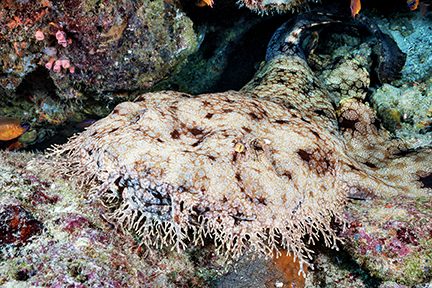
GETTING LOW, GOING SLOW
I frequently, feverishly referenced marine life identification guides throughout the week in Triton Bay. Exploration of muck diving sites allowed me to document a different cast of characters and beef up my own life list of what is witnessed in the wild there.
Froggies, nestled in a twisting, craggy, limestone-walled passage on the eastern flank of Iris Strait, had hazy 15-foot (4,6 meters) visibility but was home to a wealth of critters. Hovering just above the sloping bottom of fine, tan sediment, we carefully searched from 20 feet (6 meters) down to 60 feet (18 meters) and were generously rewarded with Tozeuma shrimp, crab-eyed gobies, upside-down jellyfish, and cryptic decorator crabs masquerading as sticks, tufts of algal scuzz, and moving rocks. If I had to choose a favorite from this dive, it would have to be the spiny tiger shrimp that’s smaller than a micro-SD memory card.
At Jack’s Spot, I missed the flamboyant cuttlefish and wonderpus that fortunate folks logged while I was locked in battle with my Nursalim nemesis, but I did enjoy a meeting with a broadclub cuttlefish that gave me the universal two-tentacled “I come in peace” salute. Or perhaps it was “Take me to your leader.” There were combtooth blennies, starry blennies, tiny triggerfish, and dragonets.
I was pleased to add to my nudibranch portfolio, including two mating Halgerdas, three mating Chromodoris, and solos of six more species just doing their own thing. My log of 37 nudibranch species recorded in a week was not too shabby, even though my competition dwarfed it. The hardcore brancher who shared our boat bested me with 65. In eight Triton trips to date, he has logged more than 150. More than 200 species of nudis have been confirmed slugging about these parts, so we both still have work to do.
The macro-fest continued back on the western side of the strait along Kira Kira’s mini walls. The many highlights included emperor shrimp hitchhiking on sea cucumbers, ornate ghost pipefish hiding in crinoids, and a juvenile sweetlips spastically wiggling nose down. I could not tear myself away from the pair of harlequin shrimp ghoulishly feasting on a sea star they had adroitly dismembered with their oversized, blue-spotted chelae (claws).
A Dr. Seuss seascape of wavy leather corals, spiraling whips, sea fans, and tall, red-topped flower tree soft corals provided an enchanting backdrop in 45 to 60 feet (14 to 18 meters) for photos of crocodilefish and lionfish at Engine Point. Our guide earned my eternal terima kasih (thank you) when he showed me a juvenile pinnate batfish, solid black bordered in orange. Its hypnotic back and forth dance with fins flowing captured the spirit and elegance of a flamenco dancer.
A return to Tangga afforded me time with creatures that went unphotographed when I was on the pygmy seahorse mission impossible, such as spindle cowries, schooling catfish, an urchin clingfish, and solar-powered nudis. Purple dottybacks, purple sea fans, and a purple frogfish flexing his fishing lure rounded out the hour.
CORAL EXTRAVAGANZA
Magnificent macro life overflows at most of the 30-something dive sites within striking range of the resort on Aiduma Island. A diver dedicated to the pursuit of exotic Lilliputians could keep their head pointed down at the sand or lush coral and thoroughly enjoy an entire week without moving so much as 50 feet (15 meters). Conversely, you could gaze exclusively up and out for the immense picture panoramas bursting with color and raining down fish. Triton Bay excelled in delivering both experiences.
Christmas Rock was our last dive. It was my wife’s birthday, and she wanted to celebrate. The site’s name seemed like a good omen. We backrolled into frothy waters and bombed straight down through a shimmering cloud of a million minnows and then paused behind an outcropping at 25 feet (7,6 meters) to catch our breath. The sea wind was blowing and wanted to take us for a ride.
We launched into the current, twisted around to kick against it, and then looked up. Black coral bushes were everywhere, sprouting from the top of boulders and cascading down into gullies. Some tangles were frosty, crystalline white; others glowed gold or caramel. Yellow soft corals tipped raspberry red exploded from the reef like the finale at a fireworks show. There were lumps of orange cup corals, trees of green cup corals, and gloriously chromatic crinoids. The layers upon layers of contrasting texture and riotous color was a coral extravaganza indeed.
And the fish! Electric blue fusiliers, yellow snapper, cardinals, sweepers, and damsels along with goatfish, glassfish, bannerfish, and angelfish. This activity was fish stew at full boil. There were no orderly schools here. All were mixed in a seething, ever-shifting mass of waves of fish crashing into each other, hectic and energetic. And the current pulled us through it all.
I went to the Kingdom of the Fishes to completely assimilate myself into the marine life around me. I wanted to disappear in chaotic crowds of fins and scales surging and swirling beneath the waves. Funny how that works: You go somewhere far, far away to lose yourself, and in doing so, find yourself. AD
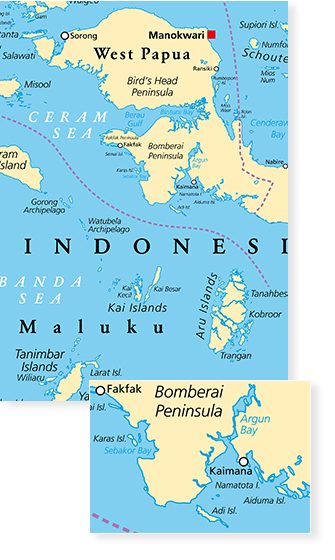
HOW TO DIVE IT
Getting there: Triton Bay, in eastern Indonesia’s West Papua province (previously called Irian Jaya), is remote; getting there takes time and effort. The best route from North America currently is to fly to Jakarta and connect to Kaimana through Sorong or Manokwari. Using Bali as your international gateway instead of Jakarta is an option, but that usually involves an additional flight or two and sometimes an overnight stay. Expect excess baggage fees, and paying cash in the local currency (Indonesian rupiah) is usually required. Flight times, routes, and even which airlines are servicing Kaimana change frequently, and it may be difficult to book flights directly from North America. The resort or liveaboard with whom you are diving should have good advice for flight and booking options.
Conditions: Triton Bay’s dive season runs from October through May. The eastern monsoon season from June to September is generally not recommended for diving because of mediocre weather and dive conditions. Water temperatures are usually in the low- to mid-80s°F (27ºC) during the dive season. Visibility is typically 25 to 40 feet (7 to 12 meters), but water clarity can vary widely from about 15 to 60 feet (4,6 to 18 meters) depending on the particular site, the amount of rain runoff from the rivers on the mainland, and the presence or absence of localized upwelling.
The air temperature hovers around 85°F (29ºC). Expect some rain during your visit. Currents, sometimes intense, are common at some dive sites. Experienced divemasters choose sites based on current conditions and guests’ skill levels and interests. Even though most diving in Triton Bay is between only 15 and 60 feet (4,6 and 18 meters) deep, dive accident insurance should be considered mandatory because of the remoteness of the destination. Manado and Ambon have hyperbaric chambers, but both places are a long way away, so dive safely and conservatively.
Other travel information: Triton Bay has only one land-based dive resort, and a few liveaboards occasionally visit the region. Malaria exists in West Papua, so bring mosquito repellent and appropriate clothing. Consult your doctor about prophylactic options. Electricity in the region is 220/230 volt 50 Hz with round two-pin type C or F sockets. Cellphone signals and Wi-Fi are likely very limited. Visit bali.com/visa-indonesia-entry-requirements-bali.html for current visa details. Indonesia now offers visa on arrival to citizens of many countries (including the U.S. and Canada) whose time in the country is less than 30 days. AD
EXPLORE MORE
Discover more of the Kingdom of the Fishes in this bonus photo gallery and video.






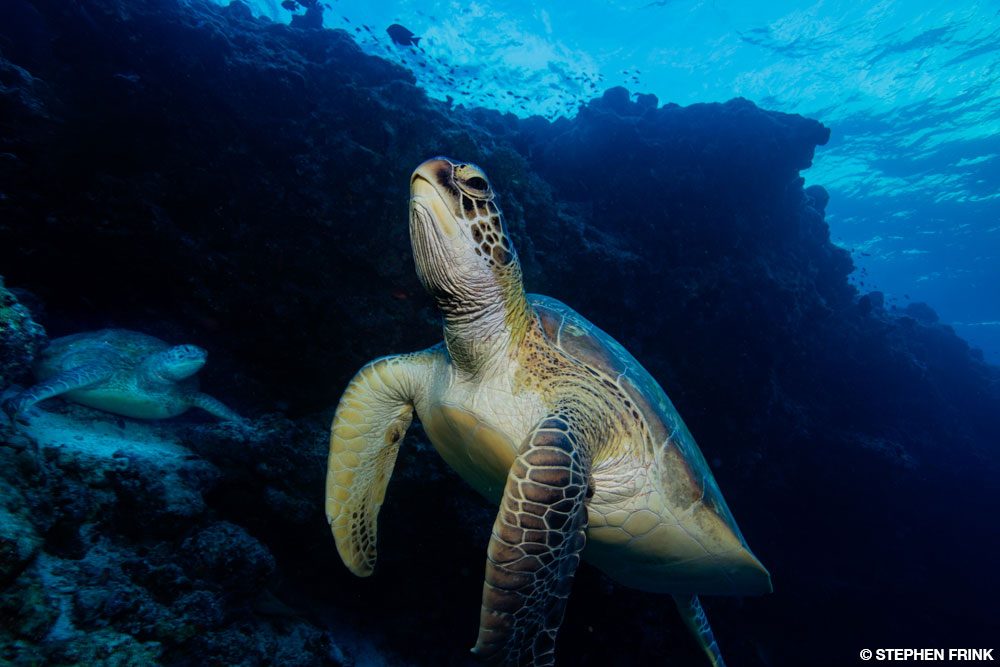


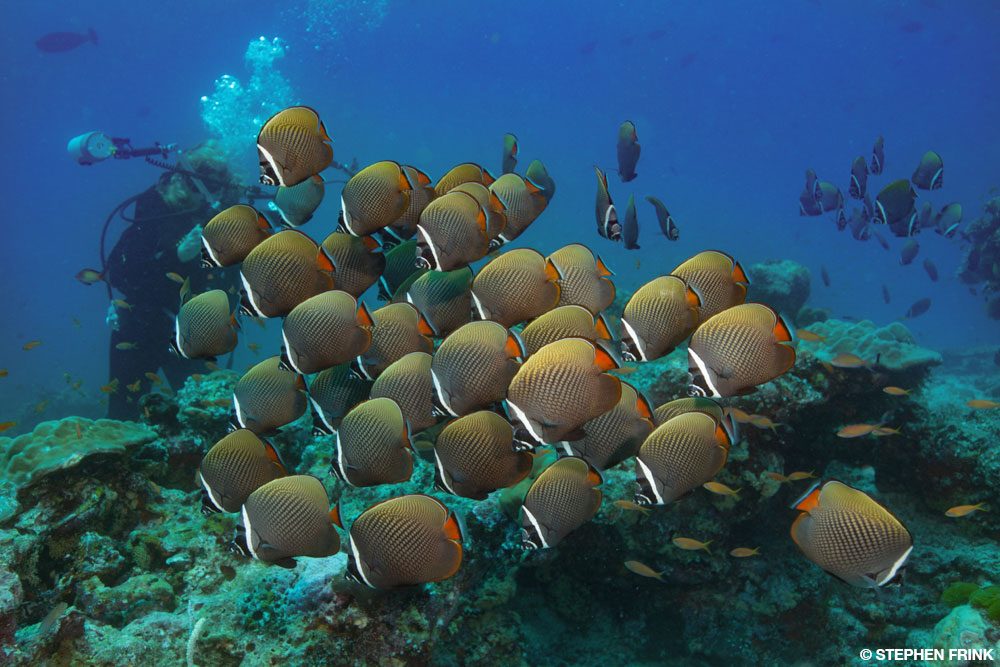

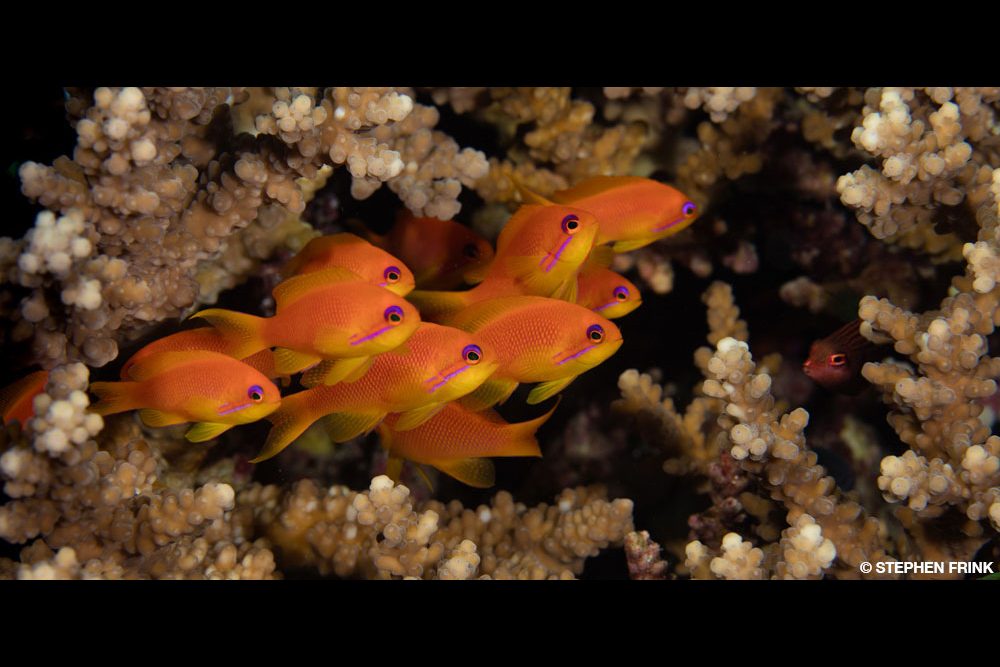
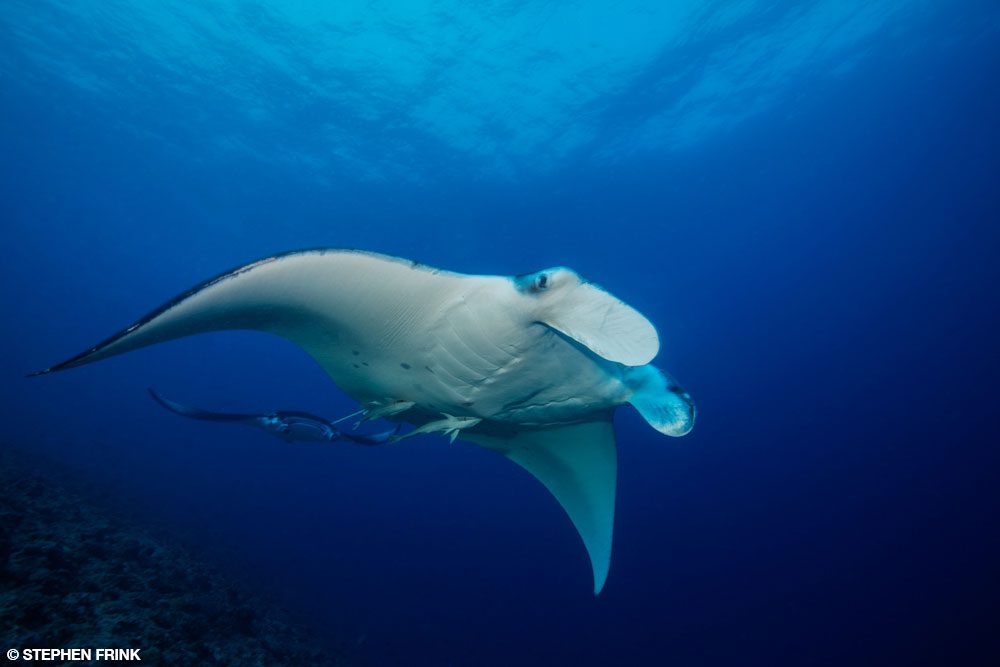
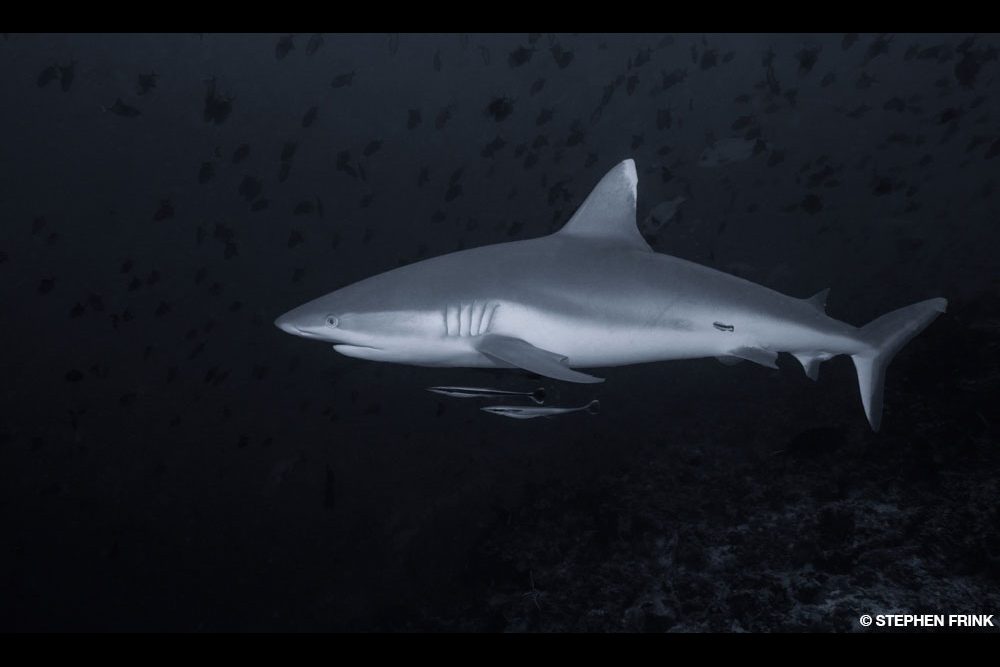
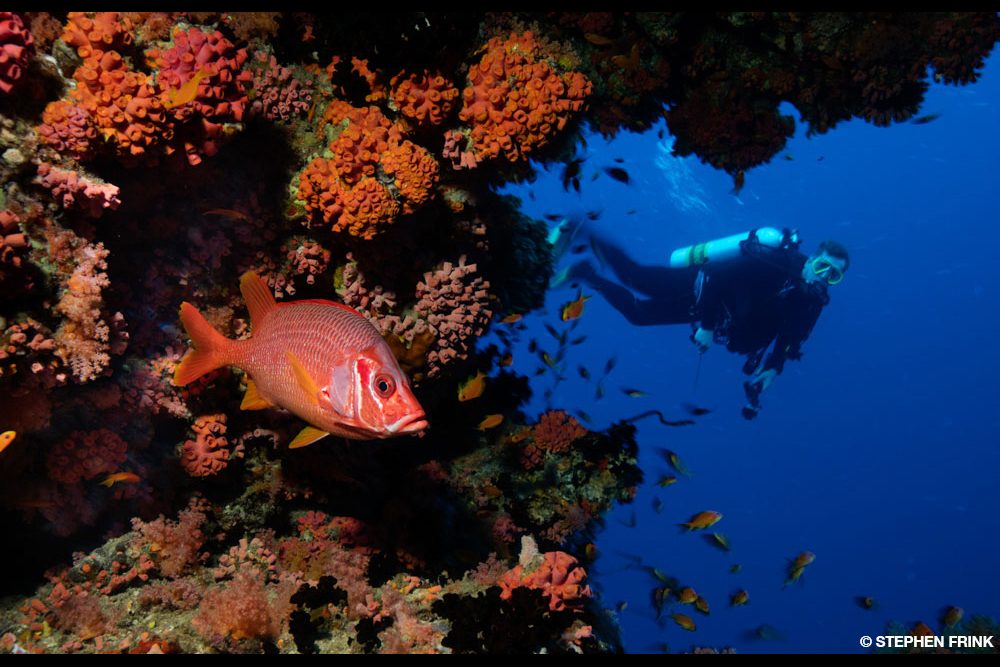
© Alert Diver — Q3 2022